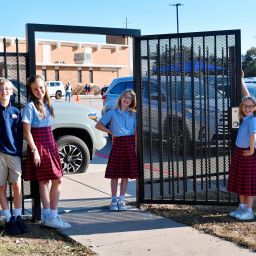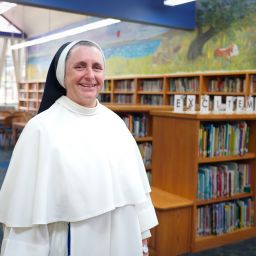
By Michael Gresham
The Texas Catholic
St. Pope John Paul II once wrote, “The aesthetic value of creation cannot be overlooked…The Bible speaks again and again of the goodness and beauty of creation, which is called to glorify God.”
Susana Zinser, who teaches Spanish at Mary Immaculate Catholic School, hoped to share that message with her students through a recent project studying the migration of Monarch butterflies.
“In my class, besides learning the language, I like to instill in my students the wonders of God’s creation, cultural awareness as well as social justice,” Zinser said. “Teaching about the Monarch butterflies gave me the opportunity to combine all three into one lesson.”
The project began with MIS fourth- and fifth-graders in November as Zinser was teaching about Día de los Muertos.
“Monarch butterflies have a special cultural meaning within the Mexican culture,” said Zinser, who explained to her students that each year the arrival of the Monarch butterflies to the forests in Central Mexico coincides with the celebration of Día de los Muertos.
“They believe that Monarch butterflies symbolize the souls of their loved ones who have died,” fourth-grader Justin Lee said. “Whenever I see a Monarch butterfly, it reminds me of my loved ones who are in Heaven.”
The students also learned that the butterflies migrate from Canada or the U.S., flying south to Mexico.
“Regardless of their country of origin, they all are welcomed in Mexico, they all live together in peace,” Zinser said.
“When Monarch butterflies are ready to migrate, they know exactly where to go,” fourth-grader Kimber Rodgers added. “When it is getting colder in the United States, Monarch butterflies migrate to warmer weather like Mexico.”
In planning the project, Zinser said she wanted students to witness the miracle of the butterfly’s metamorphosis.
“My students had the opportunity to witness the miracle of the butterflies,” Zinser said, adding that the process lasted approximately one month. “Every time my students would come to my classroom, they would check what was happening to these adorable insects. They noticed how the caterpillars changed little by little, just as we all change every day.”
Not knowing when the next change would happen, Zinser placed a camera to take a time-lapse video night and day.
“That way my students could see the transformation from caterpillar to chrysalis,” she said. “One of my fourth-grade groups witnessed the hatching of one of these butterflies. That was an awesome experience. We were all in awe of that miracle in front of our own eyes. A new life — leaving the old body behind and being transformed into a beautiful butterfly. Does that make you think about resurrection? Yes, indeed!”
Dagen Morrison, a fourth-grader at the school, said that watching the butterfly come out of its chrysalis was her favorite part of the project.
“I remember when me and the rest of the class crowded around the chrysalis and watched it slowly shake to the point where the butterfly could come out,” Morrison said. “I also enjoyed setting the butterfly free and the amazement of knowing I practically raised a butterfly.”
Even though the process lasted over a month, Zinser’s class spent only two weeks learning about Día de los Muertos and the butterfly migration, watching videos, reading a book in Spanish and learning the song “Señorita Mariposa.”
“We also made butterfly crafts and decorated trees to resemble the trees in the forests of Michoacán, Mexico,” she said.
When the time came, the class, joined by parish priest Father Alfonse Nazzaro, set the butterflies free.
“We gathered on the patio in front of the church and as the butterflies were freed, we sang the song to give them a nice farewell,” Zinser said. “It was an emotional moment for the students.”
Robbie Orchard, a fourth-grade student, was thankful Zinser chose the project this year.
“We got to learn interesting things about butterflies like their migration routes and how Monarchs fit into Mexican culture,” Orchard said. “I learned you can help Monarchs by planting milkweed to have butterflies lay eggs on and for caterpillars to eat.”
And, even though there was science involved, Zinser said that was not her focus with the project.
“My emphasis was to be in awe of God’s wonderful creation, to open my student’s minds to different cultures and traditions, and to open their hearts to people from all races and nationalities, while we practiced Spanish,” she said.







